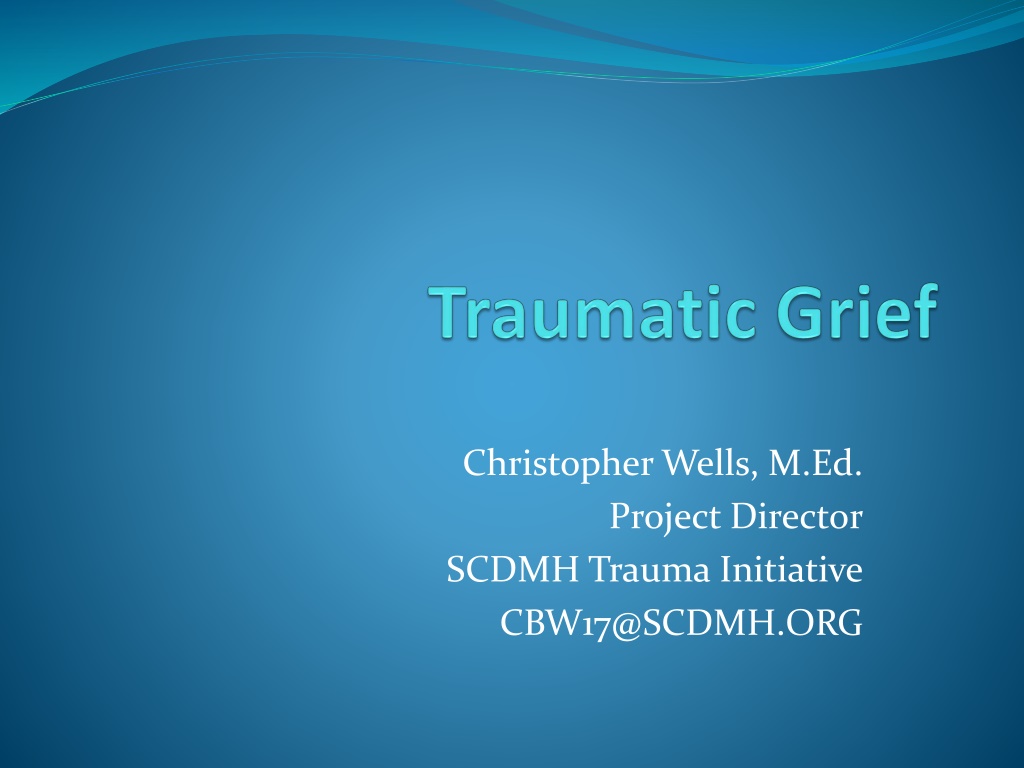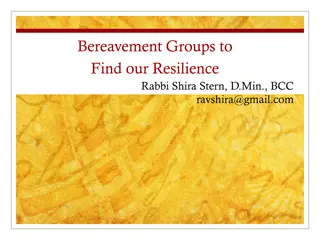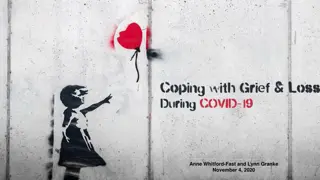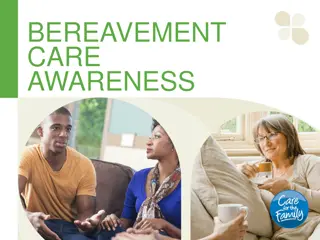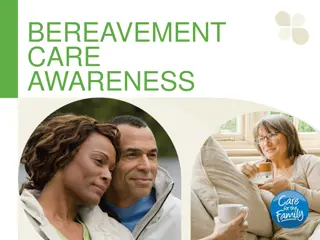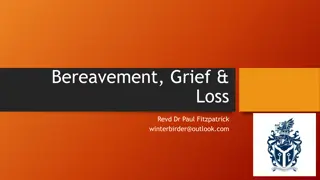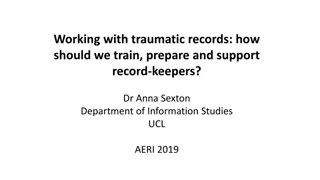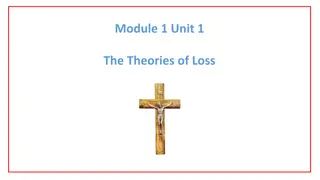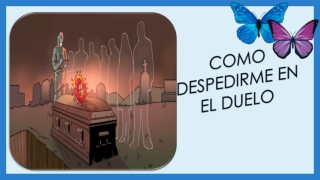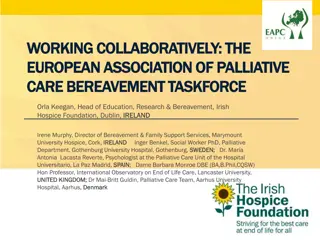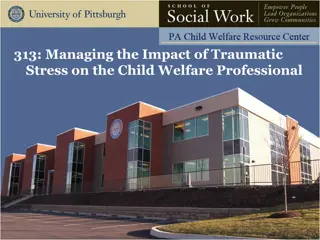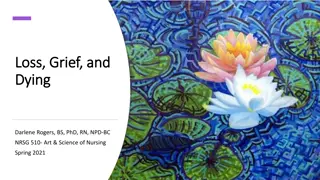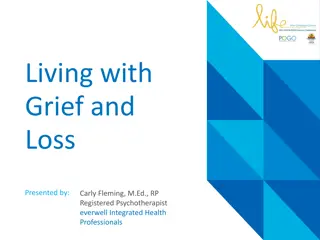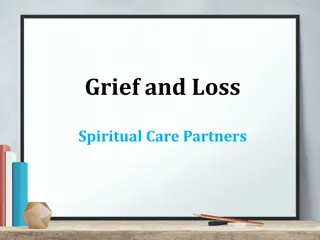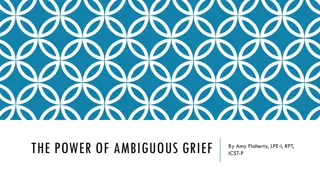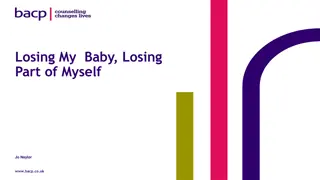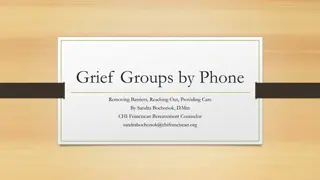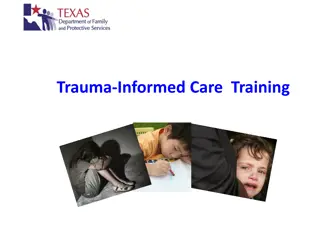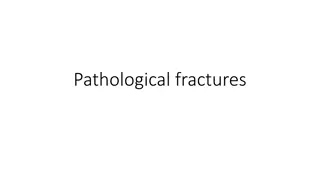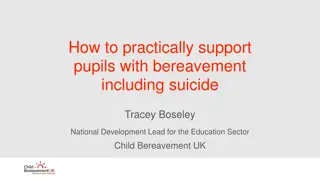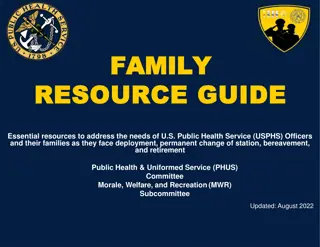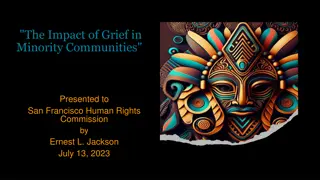Understanding Traumatic Grief and Bereavement: A Comprehensive Overview
Explore the complexities of traumatic grief, bereavement, and loss through a detailed examination of definitions, theories, stages, symptoms, impact, and risk factors. Unpack the nuances of acute grief, integrated grief, and the coping mechanisms individuals utilize when faced with profound loss. Gain insights into evidence-based practices for assessing and treating traumatic grief, and differentiate between common mental health conditions such as depression, anxiety, PTSD, and traumatic grief.
Download Presentation

Please find below an Image/Link to download the presentation.
The content on the website is provided AS IS for your information and personal use only. It may not be sold, licensed, or shared on other websites without obtaining consent from the author. Download presentation by click this link. If you encounter any issues during the download, it is possible that the publisher has removed the file from their server.
E N D
Presentation Transcript
Christopher Wells, M.Ed. Project Director SCDMH Trauma Initiative CBW17@SCDMH.ORG
Objectives Create a sense of curiosity regarding the burgeoning field of traumatic grief Identify the commonalities and distinctions between depression, anxiety, PTSD and traumatic grief Provide an introduction to evidence based practices for the assessment and treatment of traumatic grief
Overview Definitions Theories of Grief Stages of Grief Exploring Symptoms, Impact & Risk Factors Exploring Studies on Traumatic Grief Assessment Treatment
Bereavement Refers to the death of a loved one and in its broadest terms Encompasses the entire experience of family members and friends (anticipation, death, and subsequent adjustment to living following the death of a loved one) Bereavement includes the: Internal psychological processes and adaptation of family members, and expressions and experiences of grief. It also encompasses changes in external circumstances such as alterations in relationships and living arrangements.
Grief Grief is a normal reaction to loss and refers to the distress resulting from bereavement. Grief is multidimensional with physical, behavioral and meaning/spiritual components and is characterized by a complex set of cognitive, emotional and social adjustments that follow the death of a loved one. There is both variance (the intensity of their grief, its duration and the ways in which they express their grief) and similarities (distress, anxiety, yearning, sadness and pre-occupation). The majority of the population appears to cope effectively with bereavement-related distress and most people do not experience adverse bereavement-related health effects.
Acute Grief Numbness, shock and denial Sadness, longing and emptiness Anguish, loss, anger, regret and guilt Anxiety, fear, loneliness and depression
Acute Grief Depersonalization Felling overwhelmed Waves of emotion: The pangs of grief Eventual decrease in intensity and frequency
Integrated grief Typically occurs several months after the death Recognition that they have grieved Ability to think of the deceased with equanimity Return to work
Theories of Bereavement and Grief Grief Work Perspective: Breaking attachment bonds > Maintaining bonds Attachment Theory: Model Pathways to Complicated Grief Meaning Making or Meaning Reconstruction: The organization of experiences into narrative form
Theories of Bereavement and Grief (cont.) Cognitive Stress Theory: Recovery is fostered by activation of positive emotion and minimization of distress Dual Process Model: Proposes bereaved oscillate between loss oriented and restoration oriented stressors
Stages of Grief (Kubler-Ross) Denial Anger Bargaining Depression Acceptance
Stages of Grief (Maciejewski et al, 2007) Disbelief Yearning Anger Depression Acceptance
There is no evidence that all bereaved people will benefit from counseling and research has shown no benefits to arise from counseling for no other reason than that they have suffered a bereavement. Colin Murray Parkes
Higher risk of following disorders during acute bereavement Major Depression Panic Disorder Generalized Anxiety Disorder Posttraumatic Stress Disorder Increased Alcohol Use and Abuse
Pathological Grief Traumatic Grief Complicated Grief Prolonged Grief
Persistent Complex Bereavement Disorder (DSM-V) Persistent yearning/longing for the deceased. Intense sorrow and emotional pain in response to the death. Preoccupation with the deceased. Preoccupation with the circumstances of the death.
Persistent Complex Bereavement Disorder (DSM-V) REACTIVE DISTRESS TO THE DEATH Marked difficulty accepting the death. Experiencing disbelief or emotional numbness over the loss. Difficulty with positive reminiscing about the deceased. Bitterness or anger related to the loss.
Persistent Complex Bereavement Disorder (DSM-V) REACTIVE DISTRESS TO THE DEATH: Maladaptive appraisals about oneself in relation to the deceased or the death (e.g. self-blame) Excessive avoidance of reminders of the loss (eg., avoidance of individuals, places, or situations associated with the deceased
Persistent Complex Bereavement Disorder (DSM-V) SOCIAL IDENTITY DISRUPTION: A desire to die in order to be with the deceased Difficulty trusting other individuals since the death Feeling alone or detached from other individuals since the death Feeling that life is meaningless or empty without the deceased, or the belief that one cannot function without the deceased
Persistent Complex Bereavement Disorder (DSM-V) SOCIAL IDENTITY DISRUPTION: Confusion about one s role in life, or a diminished sense of one s identity (e.g., feeling that a part of oneself died with the deceased). Difficulty or reluctance to pursue interests since the loss or to plan for the future (e.g., friendships, activities)
Prevalence of Complicated grief 10-20% of bereaved people experience CG Higher rates experienced by those bereaved by : Disaster Violent death The loss of a child
Duration of Traumatic Grief The percentage of subjects who met criteria for traumatic grief declined sharply, From a little over half of the subjects in the first few weeks after the death To 6% approximately 1 year after loss. It is of interest of traumatic grief increased to 7% by the last (25-month) assessment. Prigerson et al., 1997
Complicated Grief Incorporates elements of both separation distress and traumatic distress Persists cohesively over several months and sometimes years Negative health outcomes Is distinct from both depressive and anxiety factors (Yearning, hallucinations and preoccupation) Prigerson, 1997
Complicated Grief is Associated with Clinically significant distress and impairment in work and social functioning Sleep disturbance Disruption in daily activities Suicidal thinking and behavior Impairment in relationship functioning Increased us of tobacco and alcohol
Risk Factors for Suicide During Bereavement Major Depression Past Suicidal Gestures Absence of Support from Relatives (during bereavement) Living alone after the death Alcohol abuse Agitated depressive symptoms Multiple losses (perhaps)
Development of Complicated Grief: Risk factors Low perceived social support Insecure attachment style Increased stress Positive caregiving experience with the deceased Cognitions during bereavement Personality correlates
Development of Complicated Grief: Risk factors (cont.) History of childhood separation anxiety Controlling parents Childhood abuse Death of a parent during childhood Close kinship to the deceased a history of mood disorder Marital supportiveness and dependency
Maintenance of Complicated Grief Lack of integration of the loss with existing knowledge Maladaptive beliefs and Cognitions Avoidant behaviors de Goot et al., 2007
A study of Laughter and Dissociation ..During Bereavement Duchenne laughter (giggling) involves the contractions of the orbicularis oculi muscle (the muscle that enables the eyelids to close) Non-Duchenne laughter, which is emotionless and context-driven and does not involve any muscle activity. Bonanno, 1997
A study of Laughter and Dissociation..During Bereavement Found that: That Duchenne laughter observed during a stressful interview about the death of a spouse was related to (a) the reduced experience of negative emotion, and in particular anger, (b) the increased experience of positive emotion, and (c) higher scores on a validated behavioral measure of the dissociation of awareness of distress Non-Duchenne laughter, in contrast, related to a sensitized awareness of distress, suggesting that it may have been a laugh acknowledging the feelings of distress Bonanno, 1997
A study of Laughter and Dissociation..During Bereavement Duchenne laughter was associated with recollections of increased relationship adjustment with the deceased spouse and with reduced ambivalence toward a current important other Duchenne laughter was associated with more positive emotion in observers and with observers' judgments that the participant was healthier, better adjusted, less frustrating, and more amusing, pointing to specific processes that account for why laughter enhances social bonds Bonanno, 1997
Prolonged Grief Disorder Two Categories Symptoms of separation distress: Longing and searching for the deceased Loneliness, Preoccupation with thoughts of the deceased Symptoms of traumatic distress Feelings of disbelief, mistrust, anger and shock Detachment from others Experiencing somatic symptoms of the deceased. Prigerson & Jacobs, 2001
Two Potential Pathways to the Occurrence of the Disorder These attachment behaviors can persist into adulthood and predispose to a disorder in the circumstances of a death A death can be inherently traumatic (violent, horrible, sudden, and unexpected) and fundamentally shake the assumptions about a secure life and future attachments of the bereaved survivor, Jacobs, 1999
The bereaved person with separation distress is Preoccupied with the deceased person, Seeks for remainders of the dead person and Is aroused and focused on the lost person Raphael,1997
The traumatized person is Preoccupied with the scene of the trauma and the violent encounter with death, Wishes to avoid reminders of the event Hyper vigilantly aroused and oriented to threat, danger, or the return of a similar threat. Raphael,1997
Traumatic Grief and PTSD: Similarities Stress response syndromes Symptoms Include: intrusive thoughts, emotional numbness, detachment form others, Irritabliity and anger Melhan et al., 2004
Always write angry letters to your enemies. Never mail them. Christopher Morley
Traumatic Grief and PTSD: Differences Traumatic Grief includes a prominent component of separation distress characterized by yearning and searching and bittersweet recollections of the deceased. Individuals with traumatic grief often believe that grief keeps them connected to the deceased and /or than to grieve less would be a betrayal of the deceased. These symptoms are not seen with PTSD Melhan et al., 2004
Traumatic Grief and PTSD: Differences Hyper vigilance in traumatic grief refers to searching the environment for cues of the deceased, whereas in PTSD it refers to fears that the traumatic event will be re-experienced. Sadness is the predominant affect in traumatic grief, whereas fear is foremost in PTSD. Melhan et al., 2004
Predictors of grief following the death of one's child: the contribution of finding meaning This study examined the relative contribution of objective risk factors and meaning-making to grief severity among 157 parents who had lost a child to death. Results showed that the violence of the death, age of the child at death, and length of bereavement accounted for significant differences in normative grief symptoms (assessed by the CBI). Other results indicated that the cause of death was the only objective risk factor that significantly predicted the intensity of complicated grief (assessed by the ICG). Of the factors examined in this study, sense-making emerged as the most salient predictor of grief severity, with parents who reported having made little to no sense of their child's death being more likely to report greater intensity of grief. Implications for clinical work are discussed
Birds sing after a storm; why shouldn t people feel as free to delight in whatever remains to them? Rose Fitzgerald Kennedy
A number of studies support psychobiological dysfunction Brain imaging studies show activation of the nucleus accumbens on exposure to cues of the deceased in complicated but not normal grievers CG was associated with an MAO-A variant in patients with major depression
A number of studies support psychobiological dysfunction (cont.) Deficits in autobiographical memory functions Deficits in means in problems solving Reduced heart rate with CG in contrast to increased heart rate with PTSD
Model of Pathways to Complicated Grief (Neimeyer et al., 2002) Childhood Insecurity Childhood Security DEATH OF A SIGNIFICANT OTHER Insecure Attachment Style Secure Attachment Style Threatening to: Self Happiness Survival Non-Threatening to: Self, Happiness Survival MEANING OF THE DEATH Complicated Grief: Separation Distress & Traumatic Distress Uncomplicated Grief: Acute Grief Integrated Grief
Uncomplicated Grief Accept the loss Believe that life holds meaning Sustain coherent sense of self (feel complete) Feel efficacious Maintain health and daily routine Feel trusting of, and connected to, others Reinvest in interpersonal relationships Find meaning and pleasure in pursuits Neimeyer et al., 2002
Model of Pathways to Complicated Grief (Neimeyer et al., 2002) Childhood Insecurity Childhood Security DEATH OF A SIGNIFICANT OTHER Insecure Attachment Style Secure Attachment Style Threatening to: Self Happiness Survival Non-Threatening to: Self, Happiness Survival MEANING OF THE DEATH Complicated Grief: Separation Distress & Traumatic Distress Uncomplicated Grief: Acute Grief Integrated Grief
Insecure Attachment Style Compulsive caregiving Defensive separation Excessive dependency Unstable attachment styles (disorganized) Neimeyer et al., 2002
